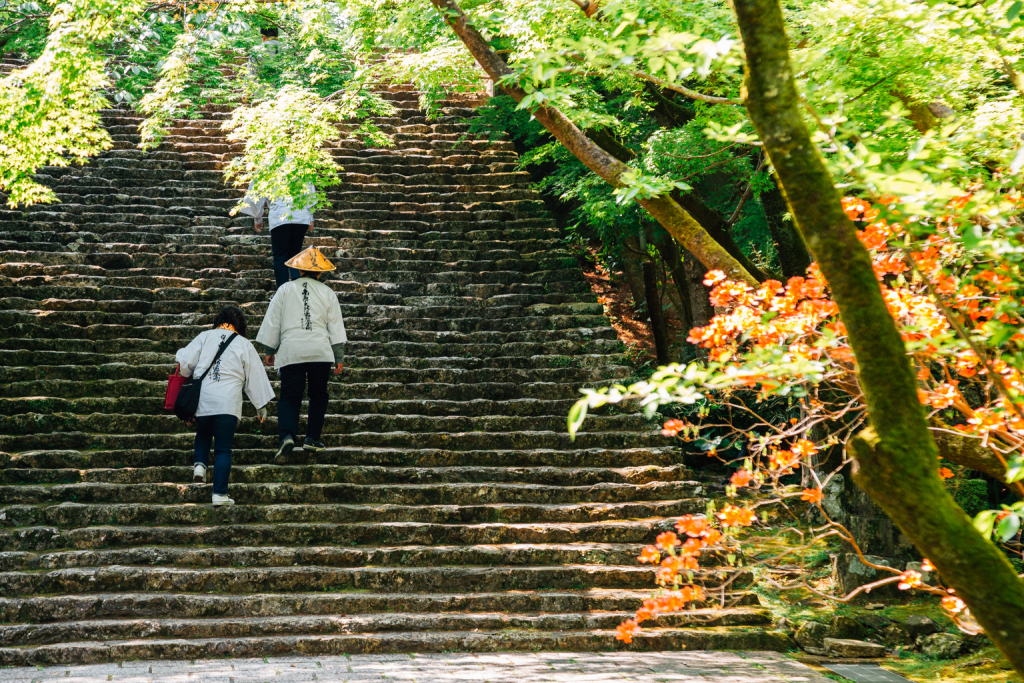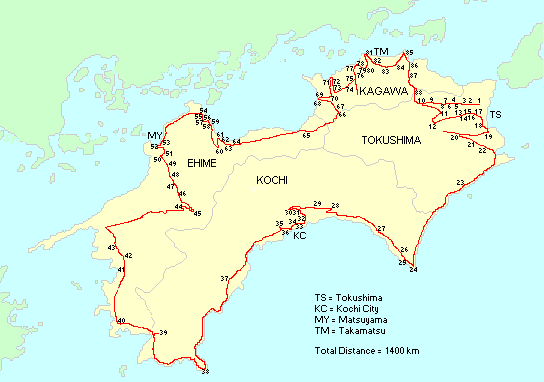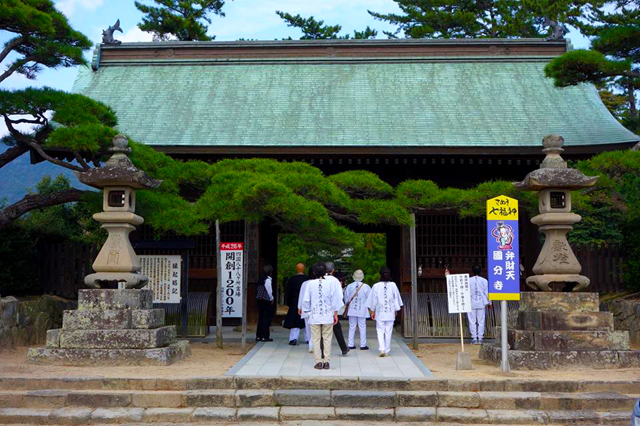Incense streaming past statues and worshipers alike, a crowd of O-henro (pilgrims) chant the hannya shingyo, or heart sutra, in eerie unison. Eyes turned downward, hands clutching prayer beads, every one hopes that their prayers and devotion will reach the inner recess of the temple where Kobo Daishi is said to reside.
By Matthew Iannarone
People go on the 88 temple pilgrimage around the island of Shikoku for a myriad of reasons—some looking for forgiveness, some to honor a commitment to a deceased family member, some merely looking to experience the beauty of Shikoku. I came to this centuries old Buddhist pilgrimage hoping to gain a foothold into my past, and insight into my future. Equipped with only a backpack, guidebook and a sense of adventure, I calmly took my first step into what turned out to be a life-changing experience.
Pilgrimage is a fundamental part of many world religions; from the Hajj in Islam and the Kumbh Mela in Hinduism to the pilgrimages to Santiago and Rome in Christianity. They allow the pilgrim to fulfill a commitment to their religion and free up time to reflect on life. The 88 temple pilgrimage fills this same need for the people who subscribe to the Shingon sect of Buddhism in Japan. Following in the footsteps of the revered saint, Kobo Daishi, this 1000-year-old Buddhist pilgrimage passes through ancient and modern Japan, across rice paddies, busy intersections and old growth forest trails.
Clearly identifying yourself as a pilgrim has many advantages; not only is it part of saturating yourself in the full experience, but people all over Shikoku will go out of their way to help you by offering you accommodation, helping you if you are lost and most of all, offering you ossetai.
Kobo Daishi (774-834), founder of the Shingon or esoteric sect of Buddhism, is one of the most important people in Japanese history, and he still holds considerable sway and respect in Japan today. Aside from being a priest, he was also a master calligrapher, poet, scholar and advisor to the emperor. In his early years, he turned away from his aristocratic upbringing and became a wandering ascetic in the mountains and valleys of Shikoku; the 88 temple pilgrimage recreates his journeys around the island. One is never far from the presence of O-Daishi-san when on Shikoku and pilgrims believe that he accompanies them throughout the journey. In fact, written on the back of every O-Henro are the words dogyo ninin (same practice, two people) and the staff that all pilgrims use is said to embody Kobo Daishi.
There are a number of ways to do the pilgrimage: on foot, by bike, car, train, bus or a combination of some or all of these. There is no “correct” procedure for doing the pilgrimage but walking is obviously the most traditional method. Most walking O-Henro start and end at temple #1 located in Naruto, near Tokushima city. But again, there is not fixed way to do it: the only rule is to end where you begin. The temples on the pilgrimage are known for their stark simplicity and rustic beauty; although each one is different they all share an underlying feeling. If the opulent temples of Kyoto and Nara were built for the nobility and upper classes, the temples on the pilgrimage were built to serve the common man. The difference is quite stark and these temples feel more meaningful and alive than their more famous counterparts on the mainland.
With a total length of around 1400 km, it takes anywhere from 45 to 60 days to complete the circuit. Some people do it in one go, and others take years to complete it, using holidays and three-day weekends. Others will only do a 3–10 day portion of it or will walk one prefecture’s worth of temples. Those who walk O-henro fall into two main camps: those who stay in paid lodging every night, and those who mainly camp and/or sleep in free accommodation. Paid-lodging types include: temples (syukudo), minshuku/ryokan, business hotels and guesthouses/hostels. They are spaced out nicely on the pilgrimage and it only involves minimal planning to secure a nice roof over your head.
To keep costs down and to feel closer to nature, many pilgrims decide to sleep nojuku, or outside, and use the plentiful amount of free accommodation located around Shikoku. Tsuyado are free places to sleep that are part of a temple complex and zenkonyado are homes or other spaces that local people provide for pilgrims for free or for a very low cost. These places are usually quite basic, sometimes only a space on a tatami floor somewhere, though at times they can be quite nice with a bath and clean futons to use. Places to pitch a tent along the pilgrimage include: michi no eki (road stations), uninhabited shrine grounds, public parks, temple grounds and beaches. The general rule is to leave places better than you find them and if there is every any question on whether or not you can camp there, please ask permission from the locals.
The trail itself is very well marked by the ubiquitous red arrows and other markers that populate the trail. The necessary 88 Route Guide, published by Buyodo, is the only guidebook written in English and contains all the information and maps you will need to walk some or all of the pilgrimage. Most O-henro also carry a stampbook (nokyocho) where they receive beautifully drawn kanji over dramatic stamps at each temple for ¥300, which can make for an amazing souvenir that will always be cherished. Pilgrims are easily identified by their white vest (hakui), sedge hat (segegasa) and wooden staff (kongozue). Clearly identifying yourself as a pilgrim has many advantages; not only is it part of saturating yourself in the full experience, but people all over Shikoku will go out of their way to help you by offering you accommodation, helping you if you are lost and most of all, offering you ossetai.
Much has been written about the unique culture of ossetai on the island of Shikoku. It roughly translates as ritualized gift giving, where local people offer pilgrims services or items for free. It can be food, canned coffee, rides, money, beer or one of the varieties of fruit that grow in hills around the island. In actuality it means much more, and gifts should be accepted humbly and with respect. By gifting ossetai, the local people are further deepening their connection to the culture of pilgrimage and continuing the 1000-year tradition. My most important ossetai when I walked the pilgrimage in early 2009 wasn’t from a local person at all, but a fellow foreign pilgrim who really taught me “how” to walk the pilgrimage, and through our conversations, made the experience real for me.
As one of the few circular pilgrimages in the world, the end of the 88 temples journey is also its beginning; but no matter what your intent may be for doing all or some of the pilgrimage, one thing is for certain: you leave Shikoku a different person.
Matthew Iannanore and his wife run a guesthouse in Matsuyama, Ehime, and one of their goals is to encourage their guests in walking or cycling O-henro. For more information about the guesthouse, please visit http://senguesthouse-matsuyama.com If you’d like more information about O-henro, please visit http://www.shikokuhenrotrail.com.
Main image: Sanga Park / Shutterstock.com











